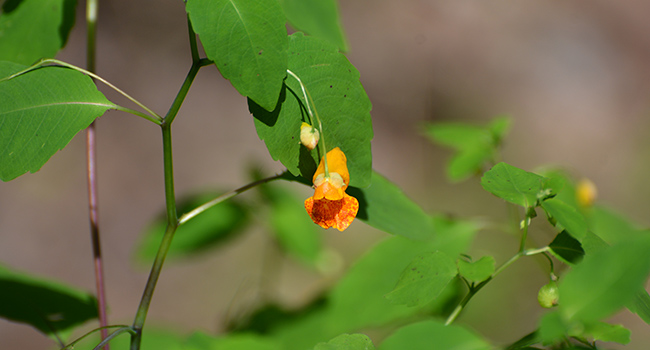
Jewelweed is also known as spotted touch-me-not – spotted because the flowers have dark spots on them and touch-me-not because if you touch the ripe seed pods, the seeds will fly out at high speed up to a metre distant

In many areas of the country grows a little plant that has remarkable medicinal qualities: jewelweed.
In my last column, I wrote about my encounter with poison ivy and the discomfort my carelessness caused me. Now I want to share more of the story.
Natural medicines are well-known and much studied, here and abroad.
Jewelweed is a beautiful shade-loving plant that grows throughout Ontario and elsewhere in Canada, filling shady nooks with its lush green foliage and delightful little orange flowers.
You may not recognize the name jewelweed, but assuredly if you’ve walked any trail near Lake Ontario or along a damp woodland edge, you’ve seen this plant.
Growing about 1.5 metres tall, the pale green leaves are soft to the touch with myriad delicate and intriguing orange flowers.
Watch for a few minutes in August and September when the blooms are at their peak and you’ll see dozens of pollinators working the tiny flowers seeking nectar and pollen. Watch more closely and don’t be surprised if hummingbirds forage on the flowers, for it’s a magnet to these tiny migratory birds. The protein and sugar-rich pollen and nectar help sustain the hummers on their way south.
Herbalists and the scientific community have long espoused the benefits of jewelweed, primarily as a proven remedy for the treatment of poison ivy and poison oak rashes.
Others tout the clear liquid that runs through the plant as the miracle cure. Claimed medicinal uses for the sap include the treatment of burns, bruises, cuts, eczema, headaches, insect bites, stings, sores, sprains, acne, warts, hemorrhoids, hives, measles and ringworm. (Kind of sounds like snake oil and it’s unlikely that all these claims are accurate.)
So how do you use this plant?
Most traditionalists and herbalists say a poultice should be made from crushed leaves as soon after exposure as possible to a toxic plant. The concoction should be held against the skin for two to three days. When you are first exposed to poison ivy, poison oak or stinging nettles, slice the stem of the jewelweed and rub the clear sap on the exposed skin. This will promptly ease irritation and usually prevents breakout.
One recipe I found suggests brewing chopped jewelweed (stems and leaves) in boiling water until a dark orange liquid forms. Strain the liquid and pour it into ice cube trays. Then if you get a skin rash, rub it with a jewelweed cube. The author claims the results are almost immediate and dramatic, and that it will keep in the freezer up to a year.
Another recipe speaks of making ‘tea’ from the leaves and the stems, which should be simmered in water until the water turns medium brown. This tea can either be bottled or frozen.
But beware – although the ‘tea’ was used historically for psychological disorders, fever reduction, vomit inducement and urinary relief, it’s not recommended that it be taken internally.
So how does jewelweed work?
This plant contains lawsone (hennotannic acid), which is an antihistamine and an anti-inflammatory. It also contains tannin (an astringent) and a fungicide used for treating athlete’s foot and ringworms.
Jewelweed can be eaten early in the season but never raw.
Before you try any of the remedies cited here, check with your medical or naturopathic doctor as different people react in different ways.
Jewelweed is also known as spotted touch-me-not – spotted because the flowers have dark spots on them and touch-me-not because if you touch the ripe seed pods, the seeds will fly out at high speed up to a metre distant.
This is an amusing and fun way to teach kids about this exciting plant while assisting with seed dispersal.
Geoff Carpentier is a published author, expedition guide and environmental consultant. Visit Geoff online at www.avocetnatureservices.com, on LinkedIn and on Facebook.
Geoff is a Troy Media Thought Leader. Why aren’t you?
The views, opinions and positions expressed by columnists and contributors are the author’s alone. They do not inherently or expressly reflect the views, opinions and/or positions of our publication.


